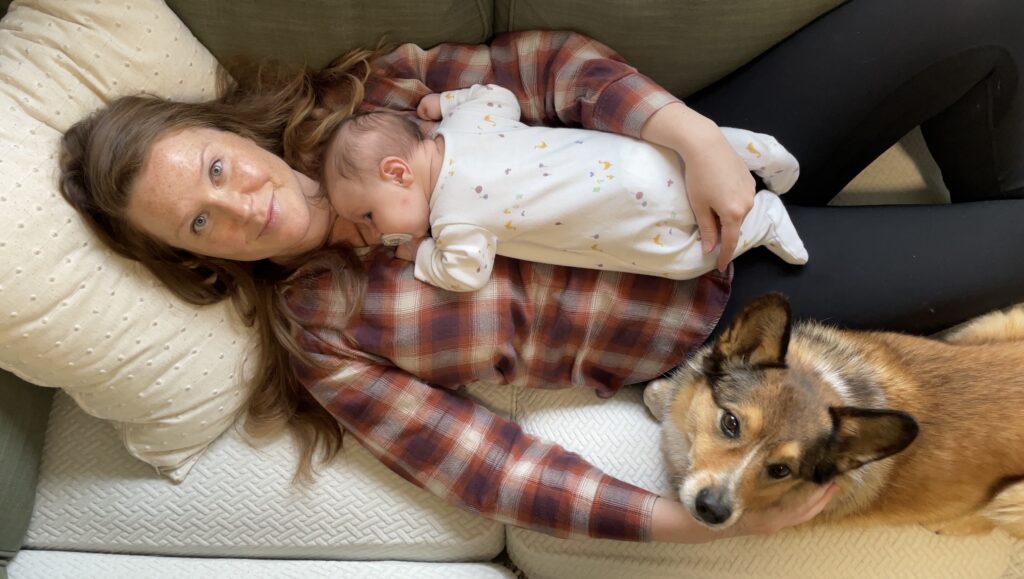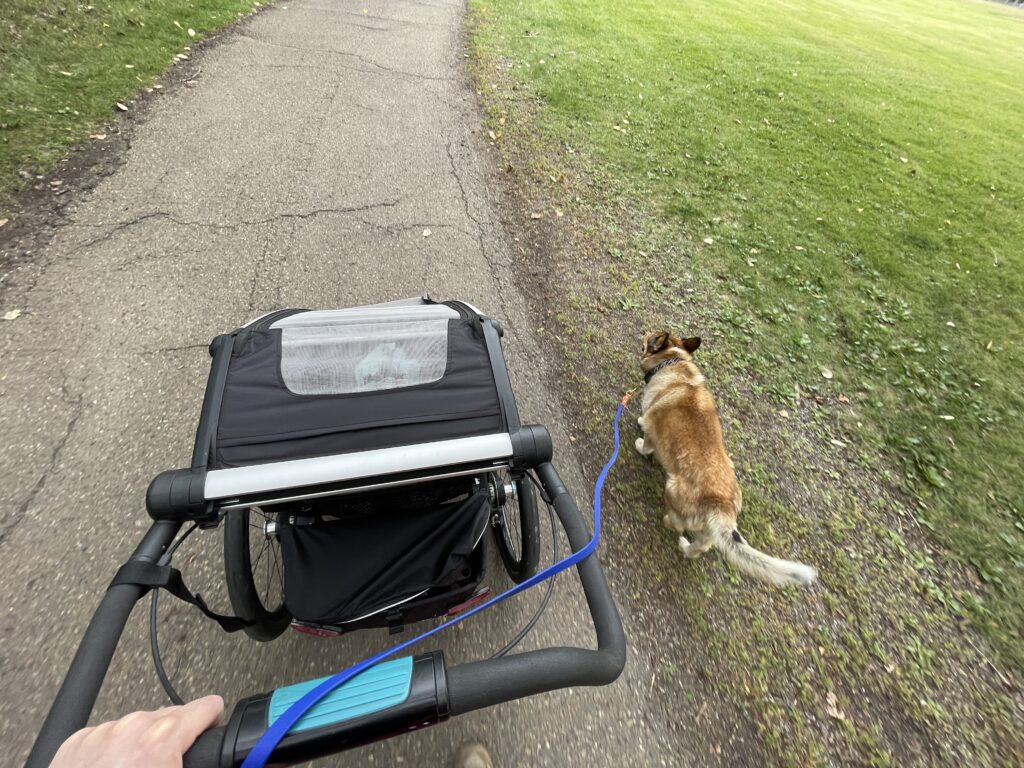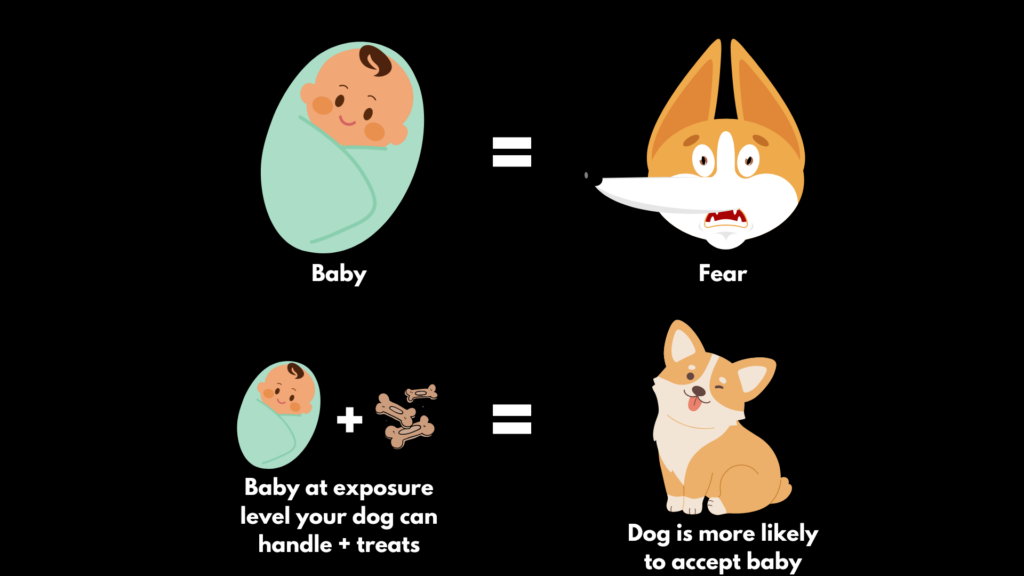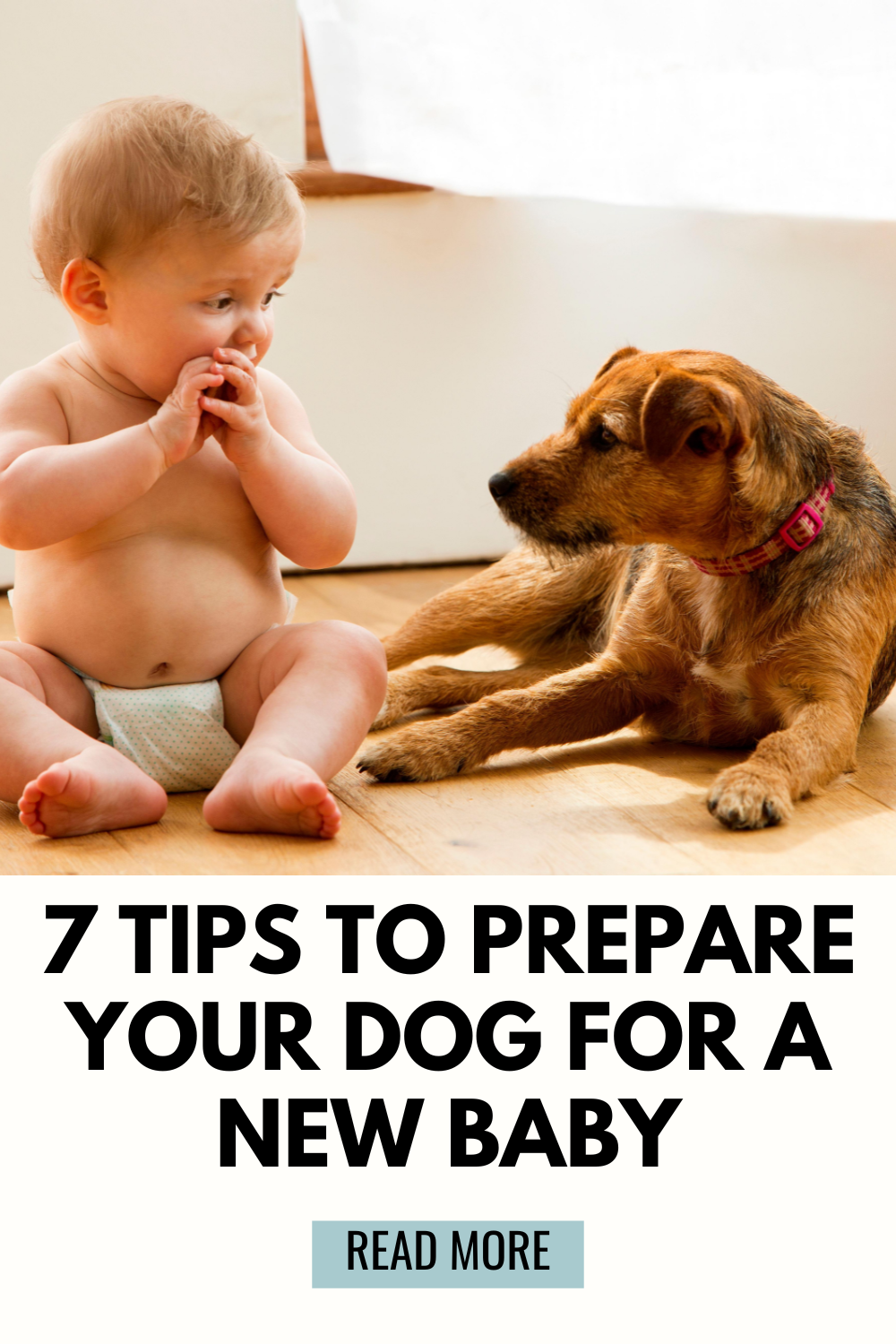If you’re expecting a baby and want to make the transition as stress-free as possible for your dog, my biggest advice is this: start preparing your dog for a baby as soon as possible!
It’s important to remember that dogs are creatures of habit and routine. While we humans may know many months in advance that a baby is coming, for dogs it can feel like an immediate shock to their life. Any preparation that you can do ahead of time is a huge kindness to your dog and will make the transition a little less stressful for everyone.

As a mom, dog guardian, and dog trainer I want to share 7 tips to prepare your dog for a new baby!
Note: This blog post is also available as a Youtube video if you prefer learning that way. You can watch it here:
Tip 1: Vet check
I strongly encourage you to take your dog to the vet prior to the baby’s arrival for a full physical exam. Similar to how we aren’t our best selves if we are injured or unwell, if your dog is struggling with any underlying pain or discomfort that is going to make them less accepting of a new stressor in the home. It’s important to address any of those issues right away.
Your vet may have other recommendations such as starting a dewormer since dogs can pass roundworms to humans, and those can be particularly harmful to children.
I encourage you to check with your vet if there’s anything specific that they would recommend for your dog.
Tip 2: Get your dog used to baby items
As mentioned, dogs are creatures of habit and routine. While expectant parents are often excited as baby gear arrives, for dogs new items suddenly appearing (particularly if they’re large) can be a stressor.
By introducing baby items now it helps your dog adjust to things such as the bassinet, the bouncy chair, and the stroller prior to your baby coming home.
The more that you can help your dog adjust to any changes around the house prior to your baby’s arrival, the smoother and less stressful it will be when your baby does come home.
Tip 3: Condition the sound of babies crying
Dogs have much more sensitive hearing than humans do, so a shrill cry from a baby can be quite upsetting to them. One of the best ways to prepare your dog for a baby is to help them build positive associations to crying prior to babies arrival. Luckily this is quite easy to do!
Start by finding audio clips of babies crying on YouTube (such as this one). To begin conditioning you’ll want to play the noise clip at the lowest level while immediately pairing that sound with treats.
Bonus tip: I find that using a pre-filled snuffle mat works best! Click HERE for the one I always recommend to clients because it has dense fabric and is machine washable.
Slowly increase the volume over a few sessions at a pace that your dog can handle without showing any signs of stress. If you want to see a full tutorial for how I work sound conditioning with a fearful dog, watch this:
Tip four: Teach new rules and routines as soon as possible
We never want our dog to associate the baby as the reason for their displacement. Therefore, I suggest trying to think of what rules and routines you currently allow and make changes immediately if you think that the baby is going to interfere with any of them.
Some things worth considering:
Will you still be okay with your dog on the couch or the bed once the baby arrives?
Are there rooms or areas such as the nursery that your dog will not be allowed in anymore ?
Will your dog be sequestered to a room or certain area when guests come over to meet the baby? Have you made sure they can settle there comfortably?
Will your dog need to ride in a new location during car rides now that there’s a car seat?
Try to really imagine what day-to-day life will look like once your baby arrives and then decide which boundaries and rules need to change. By making those adjustments prior to your baby’s arrival you can help your dog accept their new normal rather than feeling like it was the baby that displaced them.
Tip five: Make a plan for how you’ll meet your dog’s needs once the baby arrives
Babies are very time consuming and they will demand the majority of your attention. Therefore, it’s really important to recognize that you’ll be unable to offer your dog as much time and attention, particularly during the newborn phase. Even though I expected that as a new mom, I was still surprised how much guilt I felt when it actually occurred. I was grateful I’d made a plan for how I would meet my dogs needs with a newborn.
A few suggestions:
1- Stock up on new enrichment toys so your dog will have access to fun new ways of entertaining themselves. I also encourage pre-filling them so that you can easily grab one and offer it to your dog during difficult newborn moments. If you want suggestions, this video covers my dogs favourite food enrichment toys:
2- Think of how you’ll meet your dogs exercise needs. Can you plan for a family member or friend to walk your dog daily until you’re able to resume walks? Will your dog go to doggy daycare? If your dog has a lot of pent up energy it will only increase the stress in the home, so make a plan for how you’ll meet their needs.
3- Think of how you’ll meet your dogs emotional needs. If your dog is used to a lot of affection and cuddles it can be a difficult transition for them when they’re suddenly getting less attention. I also personally felt a lot of guilt when I was unable to show my dog as much affection. I requested that my husband as well as visiting family and friends made an effort to replace some of the attention that I was less able to personally offer during the early newborn phase.
Tip six: Spend time teaching valuable training skills immediately
We need to remember that it’s unfair of us to get frustrated or mad at our dogs for skills that we want them to have, but that we haven’t actually dedicated any time to teaching them.
Since you will have less time and patience for training once the baby arrives I strongly encourage you to think of what skills need training or refreshing now.
There are four skills in particular that I think you should consider:
1) “Place” or go to bed: Train your dog a verbal cue that asks them to go relax in a designated spot such as their doggy bed. This blog post explains how to train your dog to place.
2) Polite greetings: If your dog jumps on you or on guests it’s important to address that before the baby arrives for both frustration and safety. I have a step-by-step tutorial for how I train dogs not to jump up which I’ll link here:
3) Leash skills: It’s hard enough to walk with a dog and a baby even when your dog has excellent leash skills.

If your dog pulls on leash, if they chase animals, if they eat random things that they find on the sidewalk, or if they’re reactive it’ll be even more challenging to include them on walks so it’s important to address those issues now.
I have free tutorials on my Youtube channel that address all of those concerns. I’ll link my entire leash training playlist here:
I also encourage you to check out my “6 Weeks to Dream Walks” guide if you want a step-by-step leash training program to follow.
4) Window reactivity. If your dog barks at sounds and sights outside of your home, consider how much that’s going to bother you if they bark and wake up the baby. If the answer is a lot, start training that as soon as you can.
I’m going to be sharing two tutorials on Youtube for how I address window reactivity really soon. Subscribe here if you want to watch those.
Tip seven: Give your dog opportunities to be around kids now to build positive associations
Training is ALWAYS easier if you can focus exclusively on your dog rather than having your attention divided. Therefore, one of the best ways to prepare your dog for a baby (and beyond as your kid grows up) is to provide opportunities for socialization.
It’s important to remember that simply exposing your dog to something is not the same as socialization.
Exposure= unfamiliar situation + letting dog decide whether it’s good or bad.
Socialization= unfamiliar situation + positive influence= dog less likely to fear that thing in the future!
(Read more about socialization in this blog post)
Typically as a force free dog trainer we will use tasty treats to help build positive associations. Think of it like this:

Depending on your dogs comfort level, proper exposure to kids may look like:
- Going to a park and rewarding your dog each time they glance towards the kids but stay calm.
- Having a friend bring their kid over and offering your dog a long lasting treat such as a stuffed and frozen Kong while your dog hears kid noises and sees the kid move around. (Note: never let a child approach your dog while they’re eating since resource guarding can be dangerous)
- If there are older kids that your dog could meet, ask those kids to help your training by reinforcing the behaviours that you want such as sitting for greetings while you very closely supervise.
It’s easier to start building good behaviours and positive associations to kids of various ages now while you can really focus on your dog!
I hope that this blog post gave you ideas for how to prepare your dog for a baby and that it makes the transition as stress-free as possible.
If you want more dog and baby tips, check these out:
- Get Your Dog Ready for a Baby With These 7 Simple Tips!
- 8 Tips for Introducing Your Dog and Baby: A Stress-Free Approach
- Feeling Guilty for Your Dog After Baby? You’re Not Alone!
- 12 Tips for Stress-Free Walks With a Dog and Baby
- Dog Enrichment Ideas When You’re Unable to Go On Long Walks
- I’ll also link my entire dog + baby Youtube playlist here:
Happy training!
Disclosure: Happy Hounds uses affiliate links. Purchasing with these links will not cost you any extra, but I get commissions for purchases made through these links. Affiliate links help me to continue to offer free resources & blog posts. I would love if you used them!


+ show Comments
- Hide Comments
add a comment